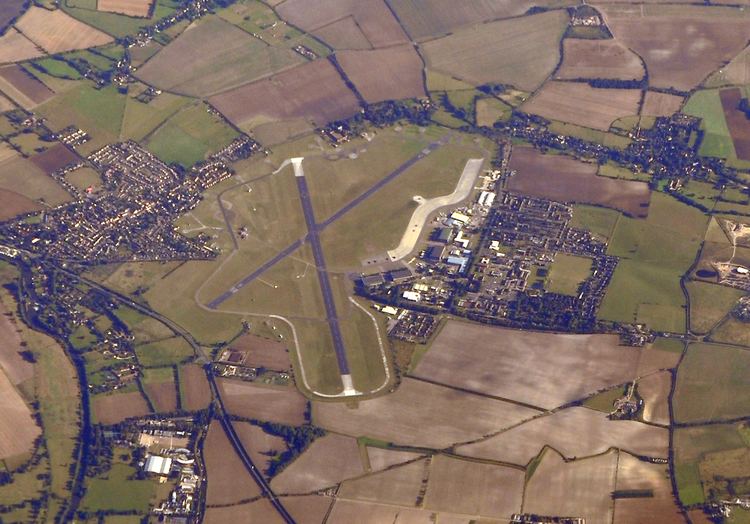Operator Royal Air Force Identifiers IATA: BEX, ICAO: EGUB Elevation 69 m Year built 1939 | In use 1939-Present Code BEX Phone +44 1491 837766 Owner Ministry of Defence | |
 | ||
Type Royal Air Force station Website www.raf.mod.uk/rafbenson/ 01/19 1,823 metres (5,981 ft) Asphalt Address Benson, Wallingford OX10 6AA, UK Profiles | ||
Royal Air Force Benson or RAF Benson (IATA: BEX, ICAO: EGUB) is a Royal Air Force station near Benson in South Oxfordshire, England. It is home to the Royal Air Force's support helicopters, the Westland Puma and the AgustaWestland Merlin, known as the Puma HC.Mk 1 and the Merlin HC.Mk 3 and Mk 3a.
Contents
Benson is currently home to 28 Squadron, 33 Squadron, 230 Squadron and also to Oxford University Air Squadron and No. 6 Air Experience Flight. In January 2008, 78 Squadron was formally stood up at RAF Benson to create, alongside 28 Squadron, a Merlin Force. Also included in the Merlin Force is the Merlin Force Engineering Squadron. No 78 Sqn were previously a Sea King/Chinook Squadron based at RAF Mount Pleasant in the Falkland Islands). In November 2009, 230 Squadron with its Puma helicopters took residence here having been posted to RAF Station Aldergrove, in Northern Ireland since the early 1990s. Previous units once located there include the Queen's Flight.
The National Police Air Service and the Thames Valley and Chiltern Air Ambulance are present on the station as lodger units. Both operate a Eurocopter EC135.
The airfield is a well-known frost hollow, often recording the coldest temperatures in the UK. In early 2009 the Met Office at RAF Benson recorded a temperature of −11.8, and on 7 January 2010, −17.1 °C.
History
Building work for RAF Benson, which was undertaken by John Laing & Son, began in 1937. RAF Benson was officially opened on Saturday 1 April 1939 and its first aircraft were two squadrons of Fairey Battle light bombers which began to arrive a few days later. No. 103 Squadron RAF started flying in on 3 April 1939, to be joined in the next few months by No. 150 Squadron RAF.
The Battles were replaced in December 1940 with Vickers Wellington medium bombers. At the same time the Supermarine Spitfires of No. 1 Photographic Reconnaissance Unit RAF and RAF Coastal Command unit arrived. It gained considerable fame as the home of photographic reconnaissance for the remainder of the Second World War. In June 1943, No. 1 PRU was formed into No. 106 Wing, with five squadrons (No’s 540 to 544 inclusive) and No. 12 Operational Training Unit RAF.
The Wing was elevated to the status of No. 106 (PU) Group in April 1944, with two de Havilland Mosquito and two Supermarine Spitfire squadrons (No. 543 Squadron having been disbanded when the aircraft strength per Squadron was increased). The No. 106 Group was assigned to the Coastal Command's Photo Reconnaissance assets with the whole of Northern Europe as its operational area.
Its Spitfire and Mosquito aircraft flew missions over occupied Europe, for example bringing back battle damage assessment pictures after Operation Chastise. This period of the station's history is reflected in the use of a full-scale replica of a wartime Spitfire PR.Mk XI on the main gate - this having replaced a genuine Spitfire PR.MK XIX that has been restored to flying status. Vera Lynn, 'the forces Sweetheart', visited RAF Benson to entertain the troops, reportedly singing "The White Cliffs of Dover" at the station.
The station retained a reconnaissance role for some years after the war, with Avro Lancaster, Spitfire, Mosquito, Gloster Meteor PR.Mk 10 and English Electric Canberra PR.Mk 3 aircraft.
Ferry Squadron RAF was here between 1956 and 1958.
On 1 June 1962 No. 105 Squadron RAF reformed at the station, flying Armstrong Whitworth AW.660 Argosys as part of the RAF Transport Command fleet. In January 1968, 114 and 267 Squadrons were flying Argosys as a Wing on the station.
The King's Flight moved from RAF Hendon and would stay (renamed as the Queen's Flight after the death of King George VI) until after the war, moving to RAF Northolt in 1995.
Current use
The station is today the home to four squadrons of Support Helicopters, 28 Squadron, 846 Naval Air Squadron with Merlin helicopters and 33 Squadron and 230 Squadron with Puma helicopters. RAF Benson is also home to the Grob Tutor light aircraft of the Oxford University Air Squadron. The station has its own flying club, which consists of service and civilian personnel. Massive investment has been made in a modern flight simulator facility for the Chinook, Merlin and Puma. RAF Benson is home to a mobile Catering Support Unit and the National Police Air Service bases one of its Eurocopter EC135 helicopters there, along with the Thames Valley and Chiltern Air Ambulance Trust (headquartered at Grove Park), Maidenhead, who moved from White Waltham to Benson in January 2007.
The future of RAF Benson was in doubt for some time, while Project Belvedere was looking into closing at least one of Joint Helicopter Command's airfields. These included Benson, Odiham, Aldergrove, Yeovilton, Middle Wallop, Wattisham and Dishforth; with the Support Helicopters based at RAF Benson being considered for a move to RAF Lyneham. Belvedere has been abandoned on cost grounds, and Benson's future is now believed to be safe.
In 2015, it was announced that The Chinook Operational Conversion Flight will transfer from RAF Odiham, in Hampshire, to Benson in "late autumn".
